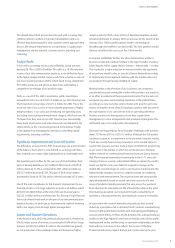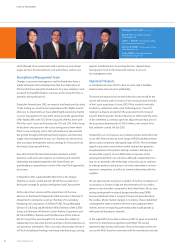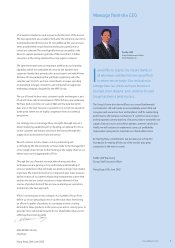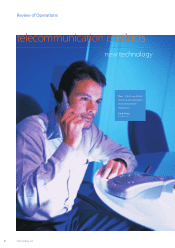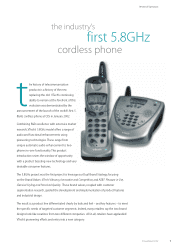Vtech 2002 Annual Report Download - page 16
Download and view the complete annual report
Please find page 16 of the 2002 Vtech annual report below. You can navigate through the pages in the report by either clicking on the pages listed below, or by using the keyword search tool below to find specific information within the annual report.
VTech Holdings Ltd14
brand building using new aesthetics
“Throughout our 25-year history, VTech Electronics has built tremendous brand
equity by developing products that combine learning, fun and technology. Today,
VTech is committed to maintaining its global leadership position by creating
products that respond to market changes and are in tune with our customers’
lifestyles and needs. Going beyond traditional curriculum-based learning, we will
include other developmental areas that are of interest to parents. The 2002/2003
product line is the first step in this new direction.”
Dennis W. PERRY
Chief Executive Officer, VTech Electronics Ltd
Market Overview
The electronic learning market is in some ways limited only by
the imagination of the companies that serve it and in the past
three years, new competition has significantly boosted
growth particularly in the United States. In 2001, the total US
market rose 8.5% to US$1.9 billion, while our principal
European market rose 3.1% to US$1.6 billion. The widening
use of personal computers may be partly responsible for this
overall trend, since they stimulate a desire among children for
electronic interactivity. The proliferation of other electronic
devices, such as PDAs, increases the scope for ELPs that cater
to young children and pre-teenagers.
The electronic learning markets in both the United States and
Europe are expected to expand continuously at these levels
over the next few years. In addition, there remains huge and
largely untapped potential in regions such as Latin America
and Asia.
Performance Review
Turnover declined by 33.5% to US$193.7 million in the
financial year 2002, and profits were also lower. The growth of
competition in the United States in recent years has led to an
erosion of VTech’s market share and declines in revenue. Even
with this decline, however, VTech remains the global leader in
electronic learning products, with a total market share of 47.
8%. Our goal this year was to revitalize the operation
and to lay the foundation for a sustained rebound in revenues
and profitability.
We achieved this by a return to the Group’s creative roots.
VTech was a pioneer in the ELP market when it launched the
first electronic learning aid, Lesson One in 1980. We then built
a highly successful business centered on the concept of
combining education and entertainment, targeting children
between six and 11 years old.
Keen competition from PCs and slow response to market
changes during the late 1990s undermined our
competitiveness in this age group. VTech responded
by expanding into the lower age group categories.
Extensive market research we commissioned from the
Omnicom Group in 2001 nonetheless showed that consumers
still held the VTech brand and its concept of “learning and fun”
in high regard. Accordingly, we took a strategic decision to
refocus on the higher-margin 6–11 year old category and
completely redesign our product range to offer a
comprehensive array across the entire spectrum from
education to entertainment. To do so, we combined our
excellent R&D with market research among consumers to
develop a completely new range of products that were
introduced this year.
product development meetingconsumer perception surveys initial product design
Review of Operations



